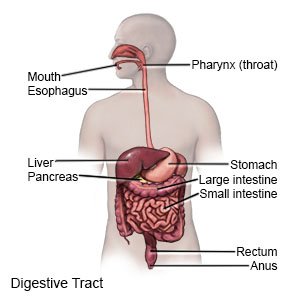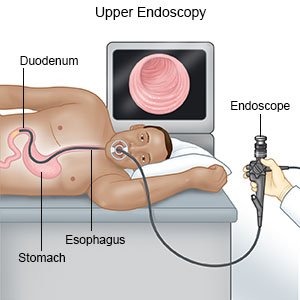Barrett Esophagus
Medically reviewed by Drugs.com. Last updated on Aug 4, 2025.
Barrett esophagus is a condition that causes cells in your esophagus to change into cells similar to intestine cells. The changed cells may become pre-esophageal cancer cells. This means they are not currently cancer but may become cancer. Dysplasia is a term used to describe the condition of having pre-cancer cells.
 |
WHILE YOU ARE HERE:
Informed consent
is a legal document that explains the tests, treatments, or procedures that you may need. Informed consent means you understand what will be done and can make decisions about what you want. You give your permission when you sign the consent form. You can have someone sign this form for you if you are not able to sign it. You have the right to understand your medical care in words you know. Before you sign the consent form, understand the risks and benefits of what will be done. Make sure all your questions are answered.
An IV
is a small tube placed in your vein that is used to give you medicine or liquids.
Medicines:
- Antinausea medicine may be given to calm your stomach and prevent vomiting.
- Anti-reflux medicines help decrease the stomach acid that can irritate your esophagus and stomach. These medicines may include proton pump inhibitors (PPI) and histamine type-2 receptor (H2) blockers.
Tests:
- Blood and bowel movement may be collected and sent to a lab for tests.
- An endoscopy is a procedure used to see the inside of your esophagus and stomach. A scope is a long, bendable tube with a light on the end of it. A camera may be hooked to the scope. A biopsy may be used to take tissue samples from your esophagus. The samples are sent to a lab to be tested for dysplasia (abnormal cell changes).

- Esophageal manometry measures the pressure in your esophagus and stomach.
- Esophageal pH monitoring measures how much acid is in your esophagus and stomach. It can also measure the amount of acid and bile that back up into the esophagus. A small probe is placed inside the esophagus to check the pH levels.
Treatment:
- Endoscopic ablation is used to destroy dysplasia cells with heat, cold, or light. Your body may be able to create healthy esophageal cells after this treatment.
- Fundoplication is a surgery that wraps the upper part of your stomach around the esophageal sphincter to strengthen it. The esophageal sphincter is the muscle at the lower end of the esophagus, right above the stomach. This may help to prevent reflux.
- Surgery may be needed to remove dysplasia cells. For high-grade dysplasia, any affected part of your esophagus may need to be removed. New esophagus tissue is created from part of your stomach or intestine.
Treatment options
The following list of medications are related to or used in the treatment of this condition.
RISKS:
Even with treatment, dysplasia cells may grow again and cause more problems. Left untreated, Barrett esophagus can develop into esophageal cancer. The cancer can spread to other parts of your body. When cancer spreads, it becomes more difficult to treat and other serious medical problems can develop.
CARE AGREEMENT:
You have the right to help plan your care. Learn about your health condition and how it may be treated. Discuss treatment options with your healthcare providers to decide what care you want to receive. You always have the right to refuse treatment.© Copyright Merative 2025 Information is for End User's use only and may not be sold, redistributed or otherwise used for commercial purposes.
The above information is an educational aid only. It is not intended as medical advice for individual conditions or treatments. Talk to your doctor, nurse or pharmacist before following any medical regimen to see if it is safe and effective for you.
Learn more about Barrett Esophagus
Treatment options
Care guides
Symptoms and treatments
Medicine.com guides (external)
Further information
Always consult your healthcare provider to ensure the information displayed on this page applies to your personal circumstances.
